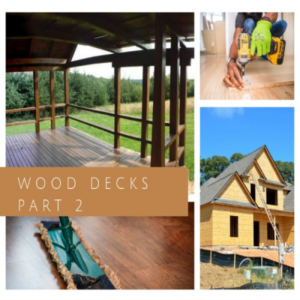Wood Decks Part 2: Maintenance Considerations

In Part 1 we discussed some of the design considerations for wood decks. Research has shown that homeowners are building larger decks now. Larger decks will provide more living space but will also come at an increased cost. The key to long term performance of a wood deck, or any outdoor wood structure, is regular, periodic maintenance. If we can identify and correct small problems before they become large, we can extend the deck life and keep problems from getting out of hand.
Maintenance Considerations
A deck should get a good spring cleaning once a year. This is an ideal time to do some inspections and possible maintenance. During the inspection be sure to examine (1) deck beams, floor joists and their attachments to major supporting posts, (2) any attachments of the deck to the adjacent building structure, (3) attachments of railings and bannisters to the deck, (4) condition of all supporting posts at the ground line, (5) cross-bracing conditions, (6) condition of all floor boards, particularly those on top of supporting joists. The yearly inspection is also a good time to apply a water-repellent preservative. This is particularly helpful for all flat surface areas which can accumulate moisture for prolonged periods. A garden sprayer is ideal for this treatment.
Refinishing
A new deck already has clean wood surfaces, but an existing deck needs to be cleaned before refinished. Select a deck cleaner to help get rid of dirt, mold, or stains to prevent damage to the surface of the wood. If you have an old deck that has turned gray, you may consider using a wood restorer and brightener. I use a pressure washer with a rotating brush head. This prevents damage to the wood that occurs with typical pressure washing and leaves the wood surface looking bright and new.
Once we have a clean and dry deck we are ready to apply the finish. Our choices are clear, semi transparent, or a solid color. This is a matter of personal preference. I prefer a clear, penetrating stain. A clear stain is the most popular for newer woods because it allows most of the wood grain to show through. Some clear finishes are made with natural color tones such as cedar or redwood to add a little pigmentation while still enhancing the natural grain. Others contain transparent iron oxide particle that block the sun’s UV rays.
Semi-transparent stains add extra color and allow the wood grow to show through, while the pigment particles physically block the sun’s UV.
Solid color stains cover the wood grain and coloring, but allows the wood texture to be prominent. It can give decks dramatic long-lasting color without the maintenance problems associated with paint.
Each type of finish has its own advantages, but the best finishes look good, repel water yet allow the wood to dry, and limit sun damage. On average a clear stain should be reapplied every 12 to 18 months. Most semi-transparent and tined stains last 3 to 4 years. The quality of the finish is essential for long-term performance.
Meet the Author
Dr. Todd Shupe is the President of Wood Science Consulting, LLC. He is a well-recognized expert on wood forensics, wood preservation, wood decay and degradation, and wood species identification. He has a broad background in new product development, quality management, and marketing and sales in both the public and private sectors. For more information please visit DrToddShupe.com.
We welcome your comments below.
Thank you for visiting. We trust that you have enjoyed reading our articles.
Liked this post? Read more below or search for more topics . . .

